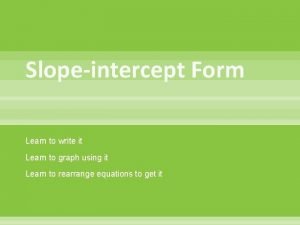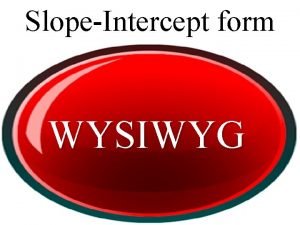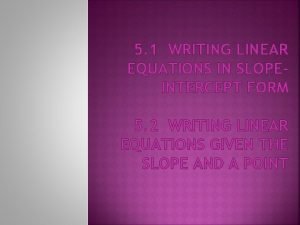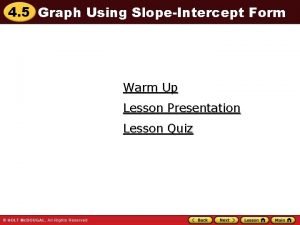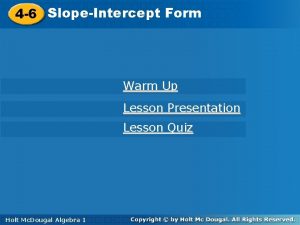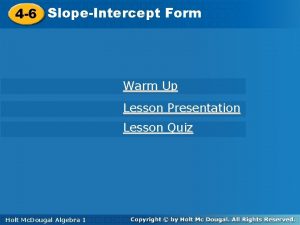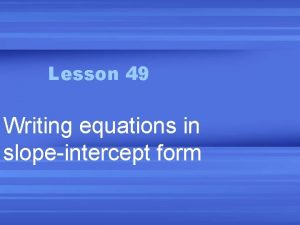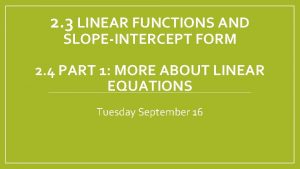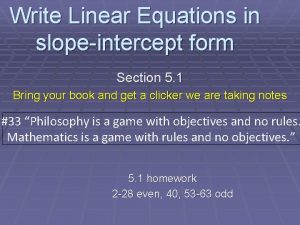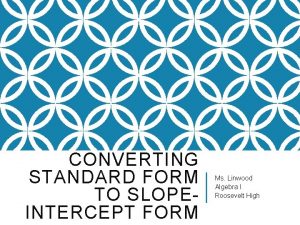Section 2 3 Linear Functions and SlopeIntercept Form














- Slides: 14

Section 2. 3 – Linear Functions and Slope-Intercept Form Consider a nonvertical line in the coordinate plane. If you move from any point on the line to any other point on the line, the ratio of the vertical change to the horizontal change is constant. That constant ratio is the slope of the line.

Section 2. 3 – Linear Functions and Slope-Intercept Form The slope of a nonvertical line is the ratio of the vertical change to the horizontal change between two points. You can calculate the slope by finding the ratio of the difference in the y-coordinates to the difference in the x-coordinates for any two points on the line.

Section 2. 3 – Linear Functions and Slope-Intercept Form

Section 2. 3 – Linear Functions and Slope-Intercept Form Problem 1: What is the slope of the line that passes through the given points? a. (-3, 7) and (-2, 4) b. (3, 1) and (-4, 1) c. (7, -3) and (7, 1) d. (5, 4) and (8, 1) e. (2, 2) and (-2, -2) f. (9, 3) and (9, -4)

Section 2. 3 – Linear Functions and Slope-Intercept Form Problem 1: Use the slope formula to show that it does not matter which point you choose for (x 1, y 1).

Section 2. 3 – Linear Functions and Slope-Intercept Form

Section 2. 3 – Linear Functions and Slope-Intercept Form A function whose graph is a linear function. You can represent a linear function with a linear equation, such as y = 6 x – 4. A solution of a linear equation is any ordered pair (x, y) that makes the equation true.

Section 2. 3 – Linear Functions and Slope-Intercept Form A special form of a linear equation is called slope -intercept form. An intercept of a line is a point where a line crosses an axis. The y-intercept of a nonvertical line is the point at which the line crosses the y-axis. The x-intercept of a nonhorizontal line is the point at which the line crosses the x-axis.

Section 2. 3 – Linear Functions and Slope-Intercept Form

Section 2. 3 – Linear Functions and Slope-Intercept Form Problem 2: What is an equation of each line? a. m = 1/5 and the y-intercept is (0, 3) b. m = 6 and the y-intercept is (0, 5) c. d.

Section 2. 3 – Linear Functions and Slope-Intercept Form Problem 4: What is the graph of -2 x + y = 1? Problem 4: What is the graph of 4 x – 7 y = 14?

Section 2. 3 – Linear Functions and Slope-Intercept Form Problem 3: Write the equation in slope-intercept form. What are the slope and y-intercept? a. 5 x – 4 y = 16 b. -3/4 x+1/2 y = -1 c. 3 x + 2 y = 18 d. -7 x – 5 y = 35

Section 2. 3 – Linear Functions and Slope-Intercept Form Lesson Check

Section 2. 3 – Linear Functions and Slope-Intercept Form Lesson Check
 What is slope intercept form definition
What is slope intercept form definition Slopeintercept form
Slopeintercept form 2-4 writing linear equations
2-4 writing linear equations Slopeintercept form
Slopeintercept form Slope intercept form part 2
Slope intercept form part 2 What is the difference between linear and exponential
What is the difference between linear and exponential Linear and quadratic functions and modeling
Linear and quadratic functions and modeling Simple linear regression and multiple regression
Simple linear regression and multiple regression Another word for symbol
Another word for symbol Linear structure in literature
Linear structure in literature Non linear pipeline
Non linear pipeline Disadvantages of non linear multimedia
Disadvantages of non linear multimedia Linear impulse and momentum
Linear impulse and momentum Contoh soal persamaan simultan
Contoh soal persamaan simultan Left linear grammar example
Left linear grammar example
